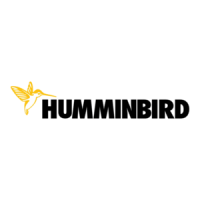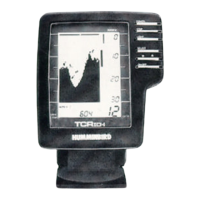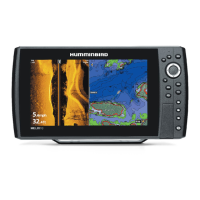Do you have a question about the Humminbird TCR 101 and is the answer not in the manual?
Details various mounting methods for the transducer, including transom, inside hull, trolling motor, and thru-hull options.
Step-by-step guide for mounting the transducer on the boat's transom.
Determining the optimal placement on the transom for consistent water contact and performance.
Instructions for attaching the metal mounting bracket to an aluminum boat transom.
Guidance on mounting the bracket on a fiberglass boat transom, including stepped transom locations.
Steps to assemble the pivot to the transducer main body using screws, washers, and nuts.
Instructions for inserting the transducer assembly into the metal bracket and securing it.
Setting the transducer angle parallel to the boat hull for optimal performance.
Verifying the transducer's depth relative to the transom for proper operation.
Choosing a suitable thin, double-hull area near the aft end of the boat for transducer placement.
Cleaning the boat hull area with lacquer thinner for proper epoxy adhesion.
Applying epoxy to bond the transducer to the hull, ensuring no air bubbles.
General warnings regarding transducer maintenance, installation errors, and troubleshooting.
Securing the swivel base to a flat surface using provided hardware for unit stability.
Attaching the gimbal bracket to the swivel base and placing rubber washers for vibration dampening.
Exploring alternative mounting methods like the SM-4 swivel mount or direct dash mounting.
Plugging in the power and transducer connectors, ensuring correct orientation and locking.
Explains the LCD technology, brightness, viewing angles, and potential effects of polarized glasses.
Describes how the screen instantly updates with new information when functions change.
How to turn the unit on/off, activate the simulator, and freeze/resume the display.
Controlling the 2-level backlight for optimal viewing in different lighting conditions.
Adjusting the automatic sensitivity setting to optimize echo detection.
Configuring an alarm to notify when the bottom depth falls within a specified range.
Setting up fish alarms for all fish or only larger fish, with volume control.
Activating and using the zoom feature to view expanded, up-close readings.
Using bottom-lock to display zoom readings relative to the bottom for structure/fish finding.
Adjusting display speed and managing automatic or manual depth range settings.
Details various mounting methods for the transducer, including transom, inside hull, trolling motor, and thru-hull options.
Step-by-step guide for mounting the transducer on the boat's transom.
Determining the optimal placement on the transom for consistent water contact and performance.
Instructions for attaching the metal mounting bracket to an aluminum boat transom.
Guidance on mounting the bracket on a fiberglass boat transom, including stepped transom locations.
Steps to assemble the pivot to the transducer main body using screws, washers, and nuts.
Instructions for inserting the transducer assembly into the metal bracket and securing it.
Setting the transducer angle parallel to the boat hull for optimal performance.
Verifying the transducer's depth relative to the transom for proper operation.
Choosing a suitable thin, double-hull area near the aft end of the boat for transducer placement.
Cleaning the boat hull area with lacquer thinner for proper epoxy adhesion.
Applying epoxy to bond the transducer to the hull, ensuring no air bubbles.
General warnings regarding transducer maintenance, installation errors, and troubleshooting.
Securing the swivel base to a flat surface using provided hardware for unit stability.
Attaching the gimbal bracket to the swivel base and placing rubber washers for vibration dampening.
Exploring alternative mounting methods like the SM-4 swivel mount or direct dash mounting.
Plugging in the power and transducer connectors, ensuring correct orientation and locking.
Explains the LCD technology, brightness, viewing angles, and potential effects of polarized glasses.
Describes how the screen instantly updates with new information when functions change.
How to turn the unit on/off, activate the simulator, and freeze/resume the display.
Controlling the 2-level backlight for optimal viewing in different lighting conditions.
Adjusting the automatic sensitivity setting to optimize echo detection.
Configuring an alarm to notify when the bottom depth falls within a specified range.
Setting up fish alarms for all fish or only larger fish, with volume control.
Activating and using the zoom feature to view expanded, up-close readings.
Using bottom-lock to display zoom readings relative to the bottom for structure/fish finding.
Adjusting display speed and managing automatic or manual depth range settings.
| Brand | Humminbird |
|---|---|
| Model | TCR 101 |
| Category | Fish Finder |
| Language | English |











